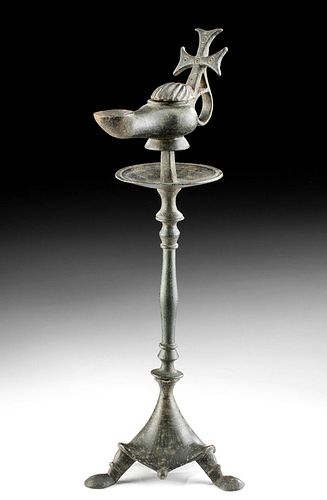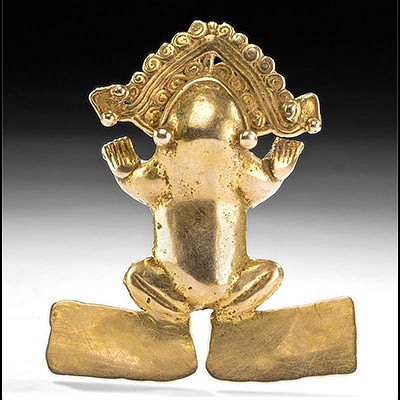Byzantine Bronze Lamp on Stand - Yale Art Museum
Lot 52
About Seller
Artemis Fine Arts
686 S Taylor Ave, Ste 106
Louisville, CO 80027
United States
Selling antiquities, ancient and ethnographic art online since 1993, Artemis Gallery specializes in Classical Antiquities (Egyptian, Greek, Roman, Near Eastern), Asian, Pre-Columbian, African / Tribal / Oceanographic art. Our extensive inventory includes pottery, stone, metal, wood, glass and textil...Read more
Categories
Estimate:
$12,000 - $15,000
Absentee vs Live bid
Two ways to bid:
- Leave a max absentee bid and the platform will bid on your behalf up to your maximum bid during the live auction.
- Bid live during the auction and your bids will be submitted real-time to the auctioneer.
Bid Increments
| Price | Bid Increment |
|---|---|
| $0 | $25 |
| $300 | $50 |
| $1,000 | $100 |
| $2,000 | $250 |
| $5,000 | $500 |
| $10,000 | $1,000 |
| $20,000 | $2,500 |
| $50,000 | $5,000 |
| $100,000 | $10,000 |
| $200,000 | $20,000 |
About Auction
By Artemis Fine Arts
Aug 13, 2020
Set Reminder
2020-08-13 10:00:00
2020-08-13 10:00:00
America/New_York
Bidsquare
Bidsquare : Fine Antiquities, Ethnographic & Fine Art
https://www.bidsquare.com/auctions/artemis-gallery/fine-antiquities-ethnographic-fine-art-5415
Features classical antiquities, ancient and ethnographic art from cultures encompassing the globe. Egyptian, Greek, Roman, Etruscan, Near Eastern, Asian, Pre-Columbian, Native American, African / Tribal, Oceanic, Spanish Colonial, Russian, Fine Art, so much more! Artemis Fine Arts info@artemisgallery.com
Features classical antiquities, ancient and ethnographic art from cultures encompassing the globe. Egyptian, Greek, Roman, Etruscan, Near Eastern, Asian, Pre-Columbian, Native American, African / Tribal, Oceanic, Spanish Colonial, Russian, Fine Art, so much more! Artemis Fine Arts info@artemisgallery.com
- Lot Description
Near East/Holy Land, Byzantium, ca. 5th to 7th century CE. A finely cast bronze oil lamp on a stand, the lamp decorated with an integrally cast Cross atop the handle, the stand a tripodal pricket stick. The lid of the lamp was cast in the form of a seashell. The symbol of the scallop shell in Christianity relates to St. James who was a fisherman in Galilee before he became a disciple of Jesus; he represents the act of pilgrimage. The shape of the shell, with grooved paths leading from the wide edge to the narrower back, can symbolize the many different paths to Christ. The shell was also meant to represent the heavenly afterlife. For example, the interior of Constantine's church of the Holy Sepulcher in Jerusalem has a scallop shell carved into the niche. Size: 5.35" W x 13.1" H (13.6 cm x 33.3 cm)
Scholars have noted that bronze lamps, generally of higher valuation than pottery lamps, were regarded as precious heirlooms safeguarded and passed down for several generations, and were reserved for the wealthiest of households. Bronze lamps like this example, were embellished with special ornaments like the Cross and the scallop shell we see here.
Provenance: ex-C.H. collection, Ann Arbor, Michigan, acquired from Royal Athena in 2004; exhibited at Yale University Art Museum, 2004-2005; ex Paris art market
All items legal to buy/sell under U.S. Statute covering cultural patrimony Code 2600, CHAPTER 14, and are guaranteed to be as described or your money back.
A Certificate of Authenticity will accompany all winning bids.
We ship worldwide and handle all shipping in-house for your convenience.
#156489The lamp and the stand fit together and can be easily separated. Rich green patina on all surfaces with light wear commensurate with age. One foot may be restored but if so it is well done and difficult to see. The lamp lid may have had its pin replaced but otherwise the lamp is intact and in excellent condition.Condition
- Shipping Info
-
All shipping is handled in-house for your convenience. Your invoice from Artemis Gallery will include shipping calculation instructions. If in doubt, please inquire BEFORE bidding for estimated shipping costs for individual items.
-
- Buyer's Premium



 EUR
EUR CAD
CAD AUD
AUD GBP
GBP MXN
MXN HKD
HKD CNY
CNY MYR
MYR SEK
SEK SGD
SGD CHF
CHF THB
THB
















